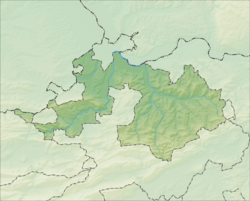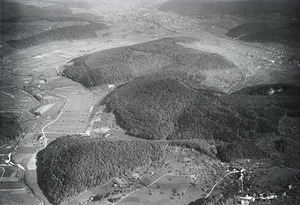Ramlinsburg facts for kids
Quick facts for kids
Ramlinsburg
|
||
|---|---|---|
|
||
| Country | Switzerland | |
| Canton | Basel-Landschaft | |
| District | Liestal | |
| Area | ||
| • Total | 2.25 km2 (0.87 sq mi) | |
| Elevation | 494 m (1,621 ft) | |
| Population
(Jun 2021 )
|
||
| • Total | 729 | |
| • Density | 324.0/km2 (839.2/sq mi) | |
| Postal code |
4433
|
|
| Surrounded by | Bubendorf, Hölstein, Itingen, Lausen, Zunzgen | |
Ramlinsburg is a small town, also called a municipality, in Switzerland. It is located in the Liestal district, which is part of the canton of Basel-Country. Ramlinsburg is known for its beautiful natural surroundings and its quiet, peaceful community.
Contents
History of Ramlinsburg
Ramlinsburg was first mentioned in official records way back in 1367. At that time, it was known as Remlisperg. It was located near the Bubendorf courthouse and was part of a region called Salland.
Early Owners and Farms
In the 1400s, a person named Henman Sevogel owned the Salland region. He was also the Lord of Castle Wildenstein, which was located between Bubendorf and Ziefen. Henman Sevogel later gave the ownership of Ramlinsburg to the Basel Bishops.
For many years, Ramlinsburg was not a town as we know it today. It was made up of just two separate farms. These farms were called Oberramlisberg (meaning "upper Ramlisberg") and Niederramlisberg (meaning "lower Ramlisberg"). Today, these old farms are known as Oberhof and Niderhof.
Growth and Merger
In the 1500s, a small town slowly started to grow around these two farms. Even as the town grew, the two farm regions remained somewhat separate. It wasn't until 1926 that Oberramlisberg and Niederramlisberg officially joined together. This merger created the single community of Ramlinsburg that we know today.
Geography of Ramlinsburg
Ramlinsburg covers an area of about 2.24 square kilometers (which is about 0.86 square miles). A large part of this area is covered by nature. About 40.6% of the land is used for farming. This means it has fields for crops or pastures for animals.
Land Use and Nature
Even more of Ramlinsburg, about 46.9%, is covered by forests. These forests are an important part of the local environment. The remaining 12.9% of the land is where buildings and roads are located.
Most of the built-up area, about 10.7%, is used for houses and other buildings. Roads and other transportation areas make up 2.2%. In the forested areas, about 45.1% is dense forest. A smaller part, 1.8%, has orchards or small groups of trees.
Farming and Location
For farming, 8.0% of the land is used for growing crops. About 27.7% is used for pastures where animals can graze. Another 4.9% is used for orchards or vineyards.
Ramlinsburg is located in the Liestal district. It sits in the northeastern part of a valley called the Vorderen Frenke valley.
Ramlinsburg's Coat of Arms
The blazon of Ramlinsburg's municipal coat of arms describes its design. It is Or, bordered Gules, two Crescents edorsed Azure. In simpler terms, this means the shield is gold (Or) with a red (Gules) border. Inside, it features two blue (Azure) crescent moon shapes that are placed back-to-back.
Population and People
Ramlinsburg has a population of about 703 people as of 2023. Over the last ten years, from 1997 to 2007, the population grew by about 36.1%.
Languages Spoken
Most people in Ramlinsburg speak German. About 93.8% of the population speaks German. French is the second most common language, spoken by about 1.4% of the people.
Where People Come From
As of 2000, about 15.6% of the people living in Ramlinsburg were born there. About 32.8% were born in the same canton (Basel-Landschaft). Another 35.4% were born somewhere else in Switzerland. Finally, about 14.4% of the population was born outside of Switzerland.
Age Groups in Ramlinsburg
In 2010, the population of Ramlinsburg included:
- Children (0-6 years old): 6.4%
- Teenagers (7-19 years old): 17.5%
- Young adults (20-29 years old): 7.0%
- Adults (30-39 years old): 11.0%
- Adults (40-49 years old): 20.6%
- Adults (50-64 years old): 21.8%
- Seniors (65-79 years old): 12.8%
- Elderly (over 80 years old): 3.0%
Households and Homes
In 2000, there were 245 private households in Ramlinsburg. On average, there were 2.6 people living in each household. About 16.3% of households had only one person. There were also 22 households with five or more people.
Most of the homes in Ramlinsburg are single-family houses. In 2000, 79.8% of the inhabited buildings were single-family homes. Many of these homes were built more recently, with 63 built between 1990 and 2000.
Population Changes Over Time
The chart below shows how Ramlinsburg's population has changed throughout history. You can see how the number of people living in the town has gone up and down over the years.

Economy and Jobs
In 2007, Ramlinsburg had a low unemployment rate of 1.59%. This means most people who wanted to work had jobs.
Types of Jobs
Jobs in Ramlinsburg are divided into three main groups:
- Primary sector: These jobs involve getting raw materials from nature. In 2005, 19 people worked in this sector, mostly in agriculture (farming). There were 6 businesses in this area.
- Secondary sector: These jobs involve making things. In 2005, 12 people worked in this sector. This included manufacturing and construction. There were 7 businesses in this area.
- Tertiary sector: These jobs involve providing services. In 2005, 42 people worked in this sector. This included things like sales, transportation, hotels, and education. There were 17 businesses in this area.
Working and Commuting
In 2008, there were 74 full-time jobs in Ramlinsburg. Most of these jobs were in the service sector (43 jobs). Construction also had a good number of jobs (16 jobs).
Many people who live in Ramlinsburg travel to other towns for work. In 2000, 287 people commuted away from Ramlinsburg for their jobs. Only 14 workers came into Ramlinsburg for work. This means Ramlinsburg is a "net exporter" of workers.
When people travel to work, about 15.6% use public transportation. A much larger number, 63.4%, use a private car to get to their jobs.
Religion in Ramlinsburg
Based on the 2000 census, people in Ramlinsburg follow different religions:
- About 17.0% of the population were Roman Catholic.
- About 56.0% belonged to the Swiss Reformed Church.
- A small number of people belonged to other Christian churches, including Orthodox and Christian Catholic.
- About 1.87% of the population was Islamic.
- About 19.81% of the population did not belong to any church. They might be agnostic (not sure about God) or atheist (do not believe in God).
Education in Ramlinsburg
Education is important in Ramlinsburg. About 39.9% of the population has completed upper secondary education. This is like finishing high school.
Higher Education
About 24.0% of the population has completed even more education. This means they have gone to a university or a Fachhochschule (a type of professional university). Of those who completed higher education, most were Swiss men (64.3%).
Students and Schools
In 2000, there were 48 students from Ramlinsburg who went to schools outside of the municipality. This means they traveled to other towns for their education.
See also
 In Spanish: Ramlinsburg para niños
In Spanish: Ramlinsburg para niños





